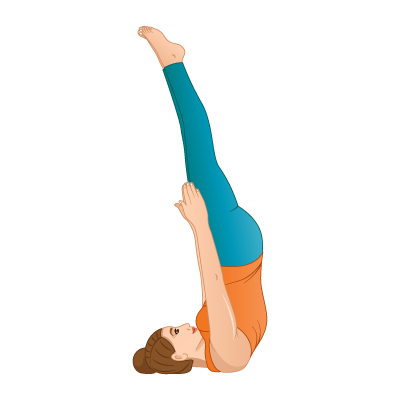Unsupported Shoulderstand
Niralamba Sarvangasana

STEPS
Unsupported Shoulderstand is an inverted balance pose, in which the body is suspended in air. While supported shoulder stand poses use the hands and/or blocks to scaffold the body, unsupported shoulder stand relies on a triangular base made by the back of the head and two shoulder points. But, that is only one of the reasons why unsupported shoulder pose is sometimes called the ‘mother’ of all poses. Unsupported shoulder stand is known for its many therapeutic benefits including stimulating the thyroid, metabolism and digestive, balancing the nervous system and relieving stress, insomnia and asthma. Unsupported Shoulderstand dates back to the 15th century Yoga Handbook, the Hatha Pradipika and is one of the 12 foundation poses of Hatha yoga.
From savasana (reclining pose). Inhale, contract the abdominal muscles and raise the legs perpendicular to the floor. Exhale; lift hips off the floor, bringing the feet above the head. Press the back of arms and palms into the floor and stretch up through the core muscles, straightening the spine and bringing shoulders, hips and feet into one line. Raise one arm and then the other vertical, along the sides of the body. Breathe normally and gaze upwards to toes. To exit the pose, lower the arms to the floor. Inhale and bend at the waist, lowering the legs over the head. On the exhale, slowly lower hips, lower, middle, then upper back to floor, vertebrae by vertebra until the body is fully reclining and back to start position.
TEACHER QUEUES
VISUALIZATION COMMENTS
When raising, imagine peeling the hips and back off the floor. When lowering hips and back imagine rolling cookie dough on the floor with your back, slowly and gently.
TECHNICAL COMMENTS
Before raising the legs, soften neck and back and anchor the shoulder blades evenly on the mat. Contract the abdominals and reach upwards strongly through the legs. In final position, the body from the shoulders to the feet is in one straight line. Broaden through the back waist and buttocks. The position of chest to chin is chin lock (Jalandhar Bandha). Lift chest to chin – NOT chin to chest.
BENEFIT COMMENTS
- Stretches the back and neck
- Strengthens and tones legs and back
- Relieves mild depression and insomnia
- Stimulates thyroid, prostrate and abdominal organs
- Improves digestion
WATCH OUT FOR
- Bent knees (fully straighten but do not tense legs)
- Turning or raising head (align the head before raising head and hips off ground)
- Bring toes too close to face (bend at waist, not back to raise legs)
- Balance issues (Practice against wall, with walking feet up wall)
CONTRAINDICATIONS
- Neck, shoulder and back injuries
- Neck and shoulder tightness
- Osteoporosis
- High blood pressure
- Glaucoma
- Pregnancy
MODIFICATIONS
- Legs-up-the-wall (Viparita Karani)
- Supported shoulder stand (with blanket under shoulders and hand supporting back)
- Half shoulder stand (rest feet on chair or pike)
- Bend knees and rest feet on wall
- Plow pose (feet over head to block or floor)
VARIATIONS
- Bring hands to elbows under the body
- Clasp hands under the body
- Bring legs into lotus
YOGA COUNTER POSES
- Plow pose
- Fish pose
- Cobra
- Wheel
Written By: Brenda Hamlet
Brenda Hamlet is a RYT 200 yoga teacher and journalist. More information about Brenda can be found at https://www.facebook.com/brendahamletyoga



